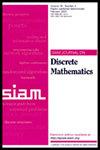Rainbow Saturation for Complete Graphs
IF 0.9
3区 数学
Q2 MATHEMATICS
引用次数: 0
Abstract
SIAM Journal on Discrete Mathematics, Volume 38, Issue 1, Page 1090-1112, March 2024.Abstract. We call an edge-colored graph rainbow if all of its edges receive distinct colors. An edge-colored graph [math] is called [math]-rainbow saturated if [math] does not contain a rainbow copy of [math] and adding an edge of any color to [math] creates a rainbow copy of [math]. The rainbow saturation number [math] is the minimum number of edges in an [math]-vertex [math]-rainbow saturated graph. Girão, Lewis, and Popielarz conjectured that [math] for fixed [math]. Disproving this conjecture, we establish that for every [math], there exists a constant [math] such that [math] and [math]. Recently, Behague, Johnston, Letzter, Morrison, and Ogden independently gave a slightly weaker upper bound which was sufficient to disprove the conjecture. They also introduced the weak rainbow saturation number and asked whether this is equal to the rainbow saturation number of [math], since the standard weak saturation number of complete graphs equals the standard saturation number. Surprisingly, our lower bound separates the rainbow saturation number from the weak rainbow saturation number, answering this question in the negative. The existence of the constant [math] resolves another of their questions in the affirmative for complete graphs. Furthermore, we show that the conjecture of Girão, Lewis, and Popielarz is true if we have an additional assumption that the edge-colored [math]-rainbow saturated graph must be rainbow. As an ingredient of the proof, we study graphs which are [math]-saturated with respect to the operation of deleting one edge and adding two edges.
完整图形的彩虹饱和度
SIAM 离散数学杂志》,第 38 卷,第 1 期,第 1090-1112 页,2024 年 3 月。 摘要如果一个边缘着色图的所有边缘都得到不同的颜色,我们就称它为彩虹图。如果[math]不包含[math]的彩虹副本,并且在[math]上添加一条任意颜色的边就会产生[math]的彩虹副本,那么一个边色图[math]就叫做[math]-彩虹饱和图。彩虹饱和度数[math]是[math]-顶点[math]-彩虹饱和图中最少的边数。吉朗、刘易斯和波皮拉尔兹猜想[math]为固定的[math]。为了推翻这一猜想,我们证明了对于每一个 [math],都存在一个常数 [math],使得 [math] 和 [math]。最近,贝哈格、约翰斯顿、莱兹特、莫里森和奥格登独立给出了一个稍弱的上界,足以推翻这个猜想。他们还引入了弱彩虹饱和度数,并询问这是否等于[math]的彩虹饱和度数,因为完整图的标准弱饱和度数等于标准饱和度数。令人惊讶的是,我们的下界将彩虹饱和度数与弱彩虹饱和度数区分开来,从而否定了这个问题。常数[math]的存在解决了他们对完整图的另一个问题。此外,我们还证明了吉朗、刘易斯和波皮拉尔兹的猜想是正确的,只要我们有一个额外的假设,即边色[math]-彩虹饱和图必须是彩虹图。作为证明的一个要素,我们研究了在删除一条边和添加两条边的操作方面是[数学]饱和的图。
本文章由计算机程序翻译,如有差异,请以英文原文为准。
求助全文
约1分钟内获得全文
求助全文
来源期刊
CiteScore
1.90
自引率
0.00%
发文量
124
审稿时长
4-8 weeks
期刊介绍:
SIAM Journal on Discrete Mathematics (SIDMA) publishes research papers of exceptional quality in pure and applied discrete mathematics, broadly interpreted. The journal''s focus is primarily theoretical rather than empirical, but the editors welcome papers that evolve from or have potential application to real-world problems. Submissions must be clearly written and make a significant contribution.
Topics include but are not limited to:
properties of and extremal problems for discrete structures
combinatorial optimization, including approximation algorithms
algebraic and enumerative combinatorics
coding and information theory
additive, analytic combinatorics and number theory
combinatorial matrix theory and spectral graph theory
design and analysis of algorithms for discrete structures
discrete problems in computational complexity
discrete and computational geometry
discrete methods in computational biology, and bioinformatics
probabilistic methods and randomized algorithms.

 求助内容:
求助内容: 应助结果提醒方式:
应助结果提醒方式:


